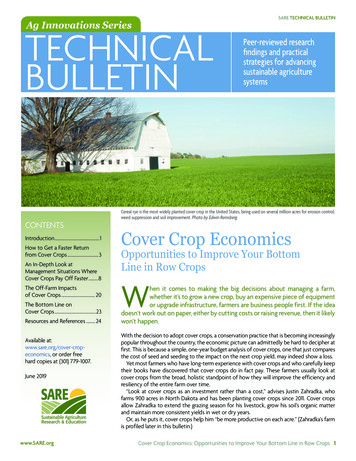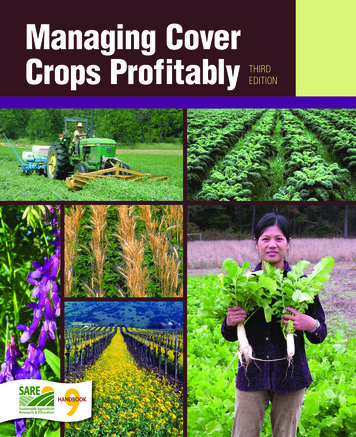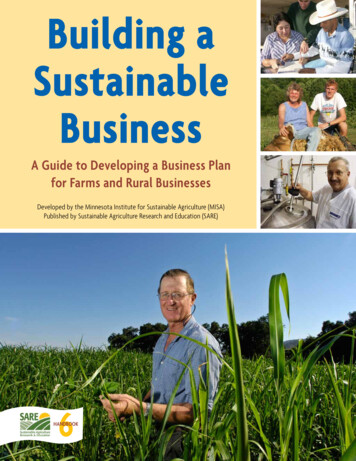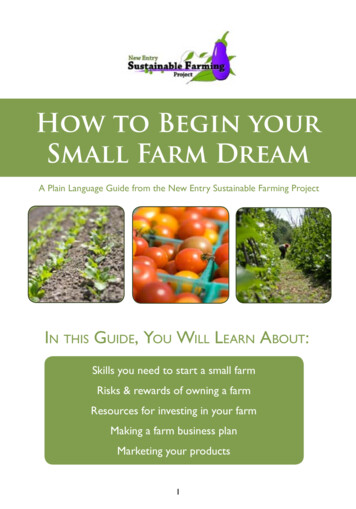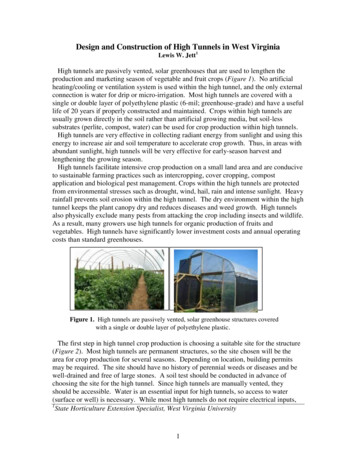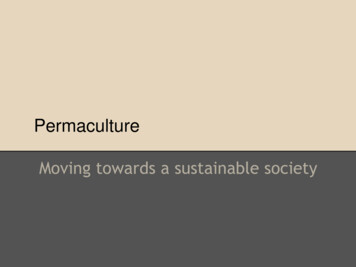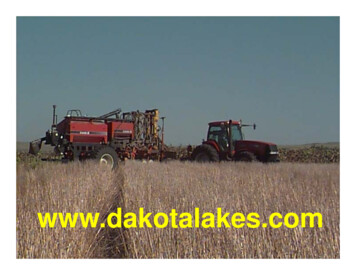
Transcription
www.dakotalakes.com
Dakota Lakes Research Farm OWNED BY FARMERSBOTH IRRIGATION AND DRYLAND100% LOW-DISTURBANCE NO-TILLPRODUCTION ENTERPRISEPROFITS SUPPORT RESEARCH
A FARMER MANAGESECOSYSTEMS AND TAKESSUNLIGHT, WATER, ANDCARBON DIOXIDE ANDMAKES THEM INTOPRODUCTS TO BE SOLD.
ECOSYSTEM PROCESSES WATER CYCLE ENERGY FLOW MINERAL CYCLE COMMUNITY DYNAMICS
ECOSYSTEM PROCESSES WATER CYCLE-Does rainfeed plants and rechargegroundwater or does it runoff and cause erosion andwater quality degradation?
The Dakota Lakes ResearchFarm began to use diverse,low-disturbance, no-till andcover cropping to controlrunoff from center-pivotirrigators.
ECOSYSTEM PROCESSES ENERGY FLOW-How muchsunlight strikes green leavesand makes food for theecosystem? How much fallson dead vegetation or bareground?
ECOSYSTEM PROCESSESThe Dakota Lakes ResearchFarm uses cover and foragecrops to fine-tune crop rotations,increase carbon capture,sequester nutrients, fix nitrogen,encourage friendlies, etc.
ECOSYSTEM PROCESSES MINERAL CYCLE-Are thenutrients available for plant useand environmental services”?Or have they been leached,eroded, or transported from thelandscape?
ECOSYSTEM PROCESSES MINERAL CYCLE-–Ecosystems that leak nutrientsbecome deserts.–Saline seeps indicate leakage–Decreasing pH indicates leakage–One unit train of soybeans contains1 million pounds of phosphorus
Saline SeepFormation
MOST NITROGEN IN FEEDHAULED TO THE FEEDLOTDOES NOT MAKE IT BACK TOTHE FIELD. MOST N IN FEEDCONSUMED IN THE FIELDREMAINS THERE.
ECOSYSTEM PROCESSES COMMUNITY DYNAMICS-Domany species (great and small) havefairly stable populations of all ages?Or does the population of just a fewspecies fluctuate widely?
ADEQUATEDIVERSITYWeeds and diseases arenature’s way of addingdiversity to a systemthat lacks diversity.
ADEQUATE DIVERSITYNature’s efforts to adddiversity can becountered by addingbeneficial diversity tothe system.
COVER AND FORAGECROPS ARE A TOOL NOT ANEND. THEY ARE A WAY TOIMPROVE ROTATIONDIVERSITY AND INTENSITYWHILE PROVIDINGCOMPETITION.
COVER and FORAGE CROPSCover and forage crops providethe opportunity to increase bothintensity and diversity insituations where production of agrain crop would not bepossible, would be unprofitable,or would be excessively risky.
COVER and FORAGE CROPSIn humid environments (tall-grassprairie or wetter) the goalshould be to have somethinggrowing at all times. In areaswith a limited growing seasonthis will require the use of covercrops and/or forage doublecrops.
COVER and FORAGE CROPSIn subhumid, semiarid, andarid environments covercrops can be utilized toincrease organic matter andbiological activity.
TOP 10 THINGS TO KNOW ABOUTCOVER CROPS Decide what you want to dobefore trying to choose a covercrop, forage crop, or covercrop mixture.
TOP 10 THINGS TO KNOW ABOUTCOVER CROPS Think of the cover crop asanother component in arotation.
TOP 10 THINGS TO KNOW ABOUTCOVER CROPS Using a mixture of cover-cropsallows meeting several goalssimultaneously. Mixtures addmore diversity, grow at differenttimes, better compete with weeds,optimize nutrient cycling, etc.
Working With Forage SoybeanSilage CornSilage Corn - Forage Soybean
TOP 10 THINGS TO KNOW ABOUTCOVER CROPS Creating conditions beneficial tothe next crop is usually one of theprimary goals of a cover-crop.
TOP 10 THINGS TO KNOW ABOUTCOVER CROPS Water and nutrient management isoften another primary goal. Waterused by a cover-crop during the noncrop period can often be regainedduring the growing season because ofbetter infiltration, reduced runoff, andimproved water relations BUT THECOVER NEEDS TO BEMAINTAINED.
Soil water content 11-4-10 and inches5.003.76Check 1VC4.00VC RVFPVFP R3.00FSFFSF RCheck 22.004-Nov29-Apr
TOP 10 THINGS TO KNOW ABOUTCOVER CROPS Understanding rainfall patterns inyour area and the water holdingcharacteristics of your soils ismandatory to fully benefit from coverand forage crop programs. USE WEBSOIL SURVEY AND RAINFALLDATA.
TOP 10 THINGS TO KNOW ABOUTCOVER CROPS Cover crop seed must beINEXPENSIVE in terms of itspotential benefit. Small seedsmean less volume/acre thusrequiring less tank fills.
TOP 10 THINGS TO KNOW ABOUTCOVER CROPS Small seeds grow better on thesurface than larger seeds whilelarge seeds usually emergebetter through a mat ofresidue.
TOP 10 THINGS TO KNOW ABOUTCOVER CROPS Using harrows to improve thestand of surface broadcast seedalso improves the stand ofweeds.
TOP 10 THINGS TO KNOW ABOUTCOVER CROPS One important goal is to use thecover crop to balance the diet ofsoil organisms. High carbonresidue (low protein) requires lowcarbon (high protein) cover cropsto balance the diet. Low residuecrops (low C) require highresidue crops (high C).
MANAGING COVERCROPS IS MOREGUESSWORK THANSCIENCE AT THISPOINT
ROTATION,SANITATION, ANDCOMPETITION ARE THEPRIMARY TOOLS OFPEST CONTROL.
CATCH ANDRELEASENUTRIENTS
“Within all textural groups, asorganic matter increased from 1 to3%, the available water capacityapproximately doubled. Whenorganic matter content increased to4%, it then accounted for morethan 60% of total AWC“.8
27,000 gallons of water with 1%OM in 6 inches of soil.This is 0.26 inches of water.If we can increase by 4% that is 1inch in the top 6 inches or 2inches in the top foot,
When soil water storage capacity islow, much of the rain that falls duringextended periods of precipitation islost. In contrast, a high water storagecapacity, combined with the effectivecapture of rain and snowmelt over thefall, winter and spring can support acrop through an extended dry period.
Commonality Among Tillage Tools All Tillage Tools Destroy Soil Structure. All tillage tools decrease waterinfiltration All tillage tools reduce organic matter All tillage tools increase weeds.
Continuous Low-DisturbanceNo-till in Combination withDiverse Rotations and CoverCrops:A BIOLOGIC ANSWER TO ABIOLOGICAL PROBLEM
to balance the diet. Low residue crops (low C) require high residue crops (high C). MANAGING COVER CROPS IS MORE GUESSWORK THAN SCIENCE AT THIS POINT. ROTATION, SANITATION, AND COMPETITION ARE THE P
